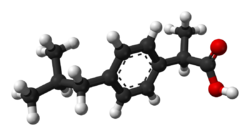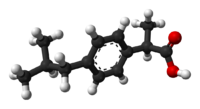Ibuprofen
 |
|
 |
|
| Systematic (IUPAC) name | |
|---|---|
| (RS)-2-(4-(2-methylpropyl)phenyl)propanoic acid | |
| Clinical data | |
| Trade names | Advil, Brufen, Motrin, Nurofen, and others |
| AHFS/Drugs.com | monograph |
| MedlinePlus | a682159 |
| Licence data | US FDA:link |
| Pregnancy cat. |
|
| Legal status | |
| Routes | Oral, rectal, topical, and intravenous |
| Pharmacokinetic data | |
| Bioavailability | 87–100% (oral), 87% (rectal)[1] |
| Protein binding | 98%[1] |
| Metabolism | Hepatic (CYP2C9)[1] |
| Half-life | 1.3-3 hours[1] onset 30 min[1] |
| Excretion | Urine (95%)[1][2] |
| Identifiers | |
| CAS number | 15687-27-1 |
| ATC code | C01EB16 G02CC01 M01AE01 M02AA13 |
| PubChem | CID 3672 |
| IUPHAR ligand | 2713 |
| DrugBank | DB01050 |
| ChemSpider | 3544 |
| UNII | WK2XYI10QM |
| KEGG | D00126 |
| ChEBI | CHEBI:5855 |
| ChEMBL | CHEMBL521 |
| PDB ligand ID | IBP (PDBe, RCSB PDB) |
| Chemical data | |
| Formula | C13H18O2 |
| Mol. mass | 206.29 g/mol |
| Physical data | |
| Density | 1.03 gr/ml g/cm³ |
| Melt. point | 75–78 °C (Expression error: Unrecognized punctuation character "�". °F) |
| Boiling point | 157 °C (315 °F) |
| |
|
It was originally synthesised and first patented in 1961, by the research arm of Boots Company led by Dr. Stewart Adams and marketed as Brufen.[6] Ibuprofen is now available under a variety of trade names around the world, with the most notable being Advil, Motrin and Nurofen.[6][7][8][9][10] Its discovery was the result of a long research programme during the 1950s and 1960s that was looking for a superior alternative to aspirin, in terms of its safety.[6][10] It was later marketed, in 1966, as a prescription drug in the United Kingdom (U.K.), then the United States (U.S.) in 1974.[6][10] Later in 1983 it became the first NSAID to be available over the counter (OTC) in the U.K. and in the U.S. in 1984.[6][10]
Like other NSAIDs it works by inhibiting the synthesis of prostaglandins, which are fat-like molecules that are derived from the omega-6 fatty acid, arachidonic acid, which are involved in mediating inflammation (swelling), pain and fever. It achieves this effect on prostaglandin synthesis by inhibiting cyclooxygenase, an enzyme that is present in various tissues of the body. Compared to other NSAIDs its potential for causing serious side effects like stomach ulcers, heart attacks or strokes is believed to be significantly less, although its effectiveness in relieving inflammation and pain is also believed to be less than that of other NSAIDs.[11]
It is on the World Health Organization's List of Essential Medicines, a list of the most important medication needed in a basic health system.[12]
Contents
Medical uses
Ibuprofen is used primarily for fever (including post-immunisation fever), mild-to-moderate pain (including pain relief after surgery), painful periods and inflammatory diseases such as osteoarthritis, juvenile idiopathic arthritis, dental pain, headache, migraine and rheumatoid arthritis.[11][13] It is also used for pericarditis and patent ductus arteriosus.[14]Ibuprofen lysine
In Europe, Australia, and New Zealand, ibuprofen lysine (the lysine salt of ibuprofen, sometimes called "ibuprofen lysinate" even though the lysine is in cationic form) is licensed for treatment of the same conditions as ibuprofen. The lysine salt increases water solubility, allowing intravenous use, and is indicated for closure of a patent ductus arteriosus in premature infants weighing between 500 and 1,500 grams (1 and 3 lb), who are no more than 32 weeks gestational age when usual medical management (e.g., fluid restriction, diuretics, respiratory support, etc.) is ineffective.[15]With regard to this indication, ibuprofen lysine is an effective alternative to intravenous indomethacin, and may be advantageous in terms of kidney function.[16] Ibuprofen lysine has been shown to have a more rapid onset of action compared to acid ibuprofen.[17]
In the UK, Ibuprofen Lysine is marketed as express pain relief, tension headache relief and more commonly migraine relief medicine. Usually available in packing of 16 342 mg tablets the pack is marketed OTC by most superstores and pharmacies as their own branded product including, but not limited to, Asda, Tesco and Superdrug.[18]
Adverse effects
Adverse effects include: nausea, dyspepsia, gastrointestinal ulceration/bleeding, raised liver enzymes, diarrhoea, constipation, nosebleed, headache, dizziness, rash, salt and fluid retention, and hypertension.[13]Infrequent adverse effects include: esophageal ulceration, heart failure, hyperkalemia, renal impairment, confusion, and bronchospasm.[13] Ibuprofen can exacerbate asthma, sometimes fatally.[19]
Ibuprofen may be quantitated in blood, plasma, or serum to demonstrate the presence of the drug in a person having experienced an anaphylactic reaction, confirm a diagnosis of poisoning in hospitalized patients, or assist in a medicolegal death investigation. A nomogram relating ibuprofen plasma concentration, time since ingestion, and risk of developing renal toxicity in overdose patients has been published.[20]
Cardiovascular risk
Along with several other NSAIDs, chronic ibuprofen use has been found correlated with risk of hypertension[21] and myocardial infarction (heart attack),[22] particularly among those chronically using high doses. In older hypertensive patients treated with hydrochlorothiazide, ibuprofen at a high daily dose was found to significantly increase systolic blood pressure.[23]Skin
Along with other NSAIDs, ibuprofen has been associated with the onset of bullous pemphigoid or pemphigoid-like blistering.[24] As with other NSAIDs, ibuprofen has been reported to be a photosensitising agent,[25] but it is considered a weak photosensitising agent compared to other members of the 2-arylpropionic acid class. Like other NSAIDs, ibuprofen is an extremely rare cause of the autoimmune disease Stevens-Johnson syndrome (SJS).[26][27]Interactions
Drinking alcohol when taking ibuprofen may increase risk of stomach bleeding.[28]According to the US Food and Drug Administration, "ibuprofen can interfere with the antiplatelet effect of low-dose aspirin, potentially rendering aspirin less effective when used for cardioprotection and stroke prevention." Allowing sufficient time between doses of ibuprofen and immediate-release (IR) aspirin can avoid this problem. The recommended elapsed time between a dose of ibuprofen and a dose of aspirin depends on which is taken first. It would be 30 minutes or more for ibuprofen taken after IR aspirin, and 8 hours or more for ibuprofen taken before IR aspirin. However, this timing cannot be recommended for enteric-coated aspirin. But, if ibuprofen is taken only occasionally without the recommended timing, the reduction of the cardioprotection and stroke prevention of a daily aspirin regimen is minimal.[29]
Overdose
Ibuprofen overdose has become common since it was licensed for OTC use. Many overdose experiences are reported in the medical literature, although the frequency of life-threatening complications from ibuprofen overdose is low.[30] Human response in cases of overdose ranges from absence of symptoms to fatal outcome despite intensive-care treatment. Most symptoms are an excess of the pharmacological action of ibuprofen, and include abdominal pain, nausea, vomiting, drowsiness, dizziness, headache, tinnitus, and nystagmus. Rarely, more severe symptoms, such as gastrointestinal bleeding, seizures, metabolic acidosis, hyperkalaemia, hypotension, bradycardia, tachycardia, atrial fibrillation, coma, hepatic dysfunction, acute renal failure, cyanosis, respiratory depression, and cardiac arrest have been reported.[31] The severity of symptoms varies with the ingested dose and the time elapsed; however, individual sensitivity also plays an important role. Generally, the symptoms observed with an overdose of ibuprofen are similar to the symptoms caused by overdoses of other NSAIDs.Correlation between severity of symptoms and measured ibuprofen plasma levels is weak. Toxic effects are unlikely at doses below 100 mg/kg, but can be severe above 400 mg/kg (around 150 tablets of 200 mg units for an average man);[32] however, large doses do not indicate the clinical course is likely to be lethal.[33] A precise lethal dose is difficult to determine, as it may vary with age, weight, and concomitant diseases of the individual person.
Therapy is largely symptomatic. In cases presenting early, gastric decontamination is recommended. This is achieved using activated charcoal; charcoal adsorbs the drug before it can enter the systemic circulation. Gastric lavage is now rarely used, but can be considered if the amount ingested is potentially life-threatening, and it can be performed within 60 minutes of ingestion. Emesis is not recommended.[34] The majority of ibuprofen ingestions produce only mild effects and the management of overdose is straightforward. Standard measures to maintain normal urine output should be instituted and renal function monitored.[32] Since ibuprofen has acidic properties and is also excreted in the urine, forced alkaline diuresis is theoretically beneficial. However, because ibuprofen is highly protein-bound in the blood, renal excretion of unchanged drug is minimal. Forced alkaline diuresis is, therefore, of limited benefit.[35] Symptomatic therapy for hypotension, gastrointestinal bleeding, acidosis, and renal toxicity may be indicated. On occasion, close monitoring in an intensive-care unit for several days is necessary. A patient who survives the acute intoxication usually experiences no late sequelae.
Miscarriage
A Canadian study published in the Canadian Medical Association Journal of thousands of pregnant woman suggests those taking any type or amount of NSAIDs (including ibuprofen, diclofenac and naproxen) were 2.4 times more likely to miscarry than those not taking the drugs.[36] However, an Israeli study following thousands of women found no increased risk of miscarriage in the group of mothers using NSAIDs.[37]Mechanism of action
The exact mechanism of action of ibuprofen is unknown. Ibuprofen is a non-selective inhibitor of cyclooxygenase, an enzyme involved in prostaglandin synthesis via the arachidonic acid pathway. Its pharmacological effects are believed to be due to inhibition cyclooxygenase-2 (COX-2) which decreases the synthesis of prostaglandins involved in mediating inflammation, pain, fever and swelling. Antipyretic effects may be due to action on the hypothalamus, resulting in an increased peripheral blood flow, vasodilation, and subsequent heat dissipation. Inhibition of COX-1 is thought to cause some of the side effects of ibuprofen including GI ulceration. Ibuprofen is administered as a racemic mixture. The R-enantiomer undergoes extensive interconversion to the S-enantiomer in vivo. The S-enantiomer is believed to be the more pharmacologically active enantiomer.[38]Nonsteroidal anti-inflammatory drugs such as ibuprofen work by inhibiting the enzyme cyclooxygenase (COX), which converts arachidonic acid to prostaglandin H2 (PGH2). PGH2, in turn, is converted by other enzymes to several other prostaglandins (which are mediators of pain, inflammation, and fever) and to thromboxane A2 (which stimulates platelet aggregation, leading to the formation of blood clots).
Like aspirin and indometacin, ibuprofen is a nonselective COX inhibitor, in that it inhibits two isoforms of cyclooxygenase, COX-1 and COX-2. The analgesic, antipyretic, and anti-inflammatory activity of NSAIDs appears to operate mainly through inhibition of COX-2, whereas inhibition of COX-1 would be responsible for unwanted effects on the gastrointestinal tract.[39] However, the role of the individual COX isoforms in the analgesic, anti-inflammatory, and gastric damage effects of NSAIDs is uncertain and different compounds cause different degrees of analgesia and gastric damage.[40]
Physical and chemical properties
It is practically insoluble in water but very soluble in most organic solvents (like ethanol, methanol, acetone and dichloromethane).[5]Stereochemistry
Ibuprofen is produced industrially as a racemate. The compound, like other 2-arylpropionate derivatives (including ketoprofen, flurbiprofen, naproxen, etc.), does contain a chiral center in the α-position of the propionate moiety. So two enantiomers of ibuprofen occur, with the potential for different biological effects and metabolism for each enantiomer. Indeed, the (S)-(+)-ibuprofen (dexibuprofen) was found to be the active form both in vitro and in vivo.It was logical, then, to consider the potential for improving the selectivity and potency of ibuprofen formulations by marketing ibuprofen as a single-enantiomer product (as occurs with naproxen, another NSAID). Further in vivo testing, however, revealed the existence of an isomerase (alpha-methylacyl-CoA racemase), which converted (R)-ibuprofen to the active (S)-enantiomer.[41][42][43]
 |
 |
 |
 |
 |
 |
Synthesis
The synthesis of this compound is a popular case study in green chemistry. The original Boots synthesis of ibuprofen consisted of six steps, started with the Friedel-Crafts acetylation of isobutylbenzene. Reaction with ethyl chloroacetate (Darzens reaction) gave the α,β-epoxy ester, which was hydrolyzed and decarboxylated to the aldehyde. Reaction with hydroxylamine gave the oxime, which was converted to the nitrile, then hydrolyzed to the desired acid:[44][45]An improved synthesis by BHC required only three steps. This improved synthesis won the Presidential Green Chemistry Challenge Greener Synthetic Pathways Award in 1997.[46] After a similar acetylation, hydrogenation with Raney nickel gave the alcohol, which underwent palladium-catalyzed carbonylation:[44][47]
An electrochemical carboxylation of a para-isobutyl benzyl chloride to Ibuprofen is promoted under supercritical carbon dioxide.[48]
History
Ibuprofen was derived from propionic acid by the research arm of Boots Group during the 1960s.[9] It was discovered by Andrew RM Dunlop, with colleagues Stewart Adams, John Nicholson, Vonleigh Simmons, Jeff Wilson and Colin Burrows, and patented in 1961. The drug was launched as a treatment for rheumatoid arthritis in the United Kingdom in 1969, and in the United States in 1974. Adams initially tested his drug on a hangover.[6] He was subsequently awarded an OBE in 1987. Boots was awarded the Queen's Award for Technical Achievement for the development of the drug in 1987.[6]Availability
See also: List of ibuprofen brand names
Ibuprofen was made available under prescription in the United Kingdom in 1969, and in the United States in 1974.[49] In the years since, the good tolerability profile, along with extensive experience in the population, as well as in so-called phase IV trials (post-approval studies), has resulted in the availability of ibuprofen OTC in pharmacies worldwide, as well as in supermarkets and other general retailers.[citation needed]North America
Ibuprofen is commonly available in the United States up to the FDA's 1984 dose limit OTC, rarely used higher by prescription.[50] In 2009, the first injectable formulation of ibuprofen was approved in the United States, under the trade name Caldolor.[51][52] Ibuprofen was the only parenteral for both pain and fever available in the country prior to the approval of Ofirmev (acetaminophen) injection by the FDA.[53]Research
Ibuprofen is sometimes used for the treatment of acne, because of its anti-inflammatory properties and has been sold in Japan in topical form for adult acne.[54][55] As with other NSAIDs, ibuprofen may be useful in the treatment of severe orthostatic hypotension (low blood pressure when standing up).[56] In some studies, ibuprofen showed superior results compared to a placebo in the prevention of Alzheimer's disease, when given in low doses over a long time.[57][58]Ibuprofen has been associated with a lower risk of Parkinson's disease, and may delay or prevent it. Aspirin, other NSAIDs, and paracetamol (acetaminophen) had no effect on the risk for Parkinson's.[59] In March 2011, researchers at Harvard Medical School announced in Neurology that ibuprofen had a neuroprotective effect against the risk of developing Parkinson's disease.[60][61][62] People regularly consuming ibuprofen were reported to have a 38% lower risk of developing Parkinson's disease, but no such effect was found for other pain relievers, such as aspirin and paracetamol. Use of ibuprofen to lower the risk of Parkinson's disease in the general population would not be problem-free, given the possibility of adverse effects on the urinary and digestive systems.[63]






Hi, Bishal. I didn't know that Ibuprofen can make asthma worse and as I was searching for information about this, I saw this blog post of yours. Thank you for the very rich, scientific information you shared here about this medicine. Can I use it in our asthma articles at https://cathay-yss.com/articles/ ?
ReplyDelete